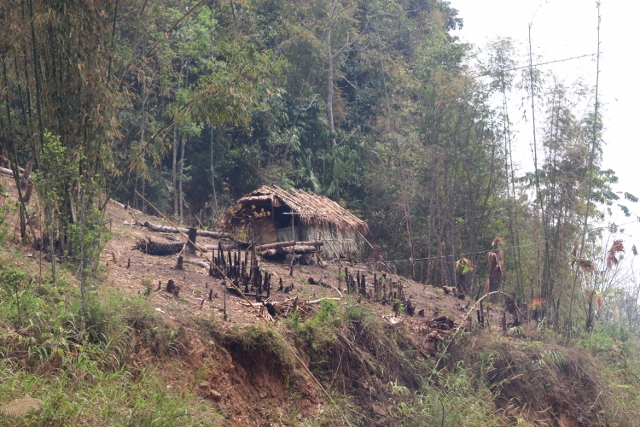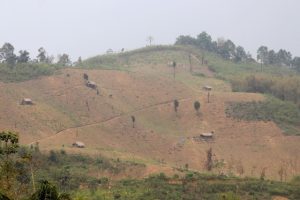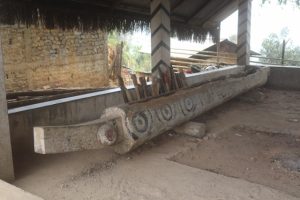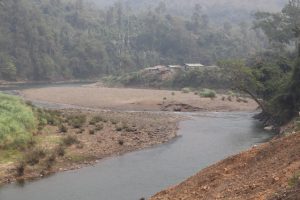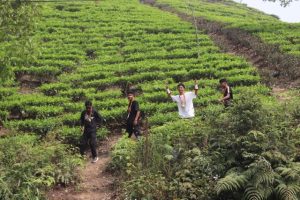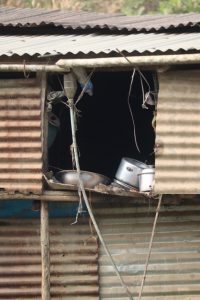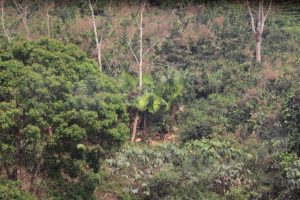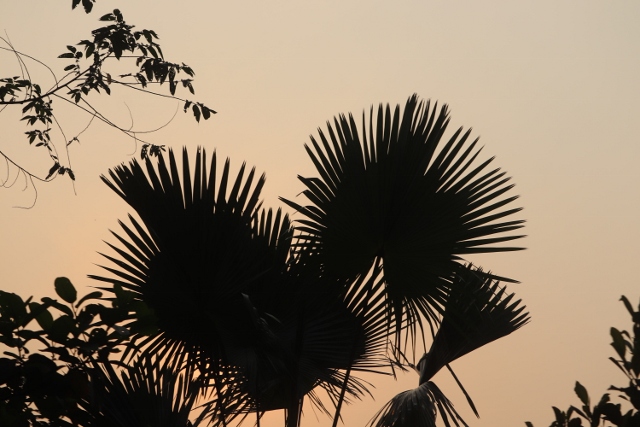
one of the carvings in the new morung of Kangching – showing technological progress -,on the road to Longwa
Although distances aren’t very large, between towns in Nagaland, the quality and the design – winding up and down mountain slopes – of the roads is such that driving takes a long time. From Mokokchung to Longwa is less than 200 km; yet, it takes us a full day. But, as almost every day, we enjoy the natural beauty of the hills, the lush vegetation.
Kangching
A couple of hours into our journey, in Kangching, we notice a nice morung – the typical meeting houses for the male youths of the village. We stop to admire the structure, the hollowed-out tree drum inside, and especially the many sticks with which to generate sound from the drum: many of those have been carved with the head of a hornbill, the sacred bird of the Naga tribes.
Then we learn how proud the people here can be. First a man approaches us, and tells us to follow him, and then runs away at a pace we are really no longer able to follow. But we move in the right direction, and a few minutes later another man appears – obviously warned by the runner -, wearing an Indian army uniform jacket. Which he must have put on for the occasion of foreign visitors. And which has no less than six medals pinned on it. He is the only veteran in the village, from the Chinese-Indian war of 1962, where he was decorated. He is proud of his medals; his fellow villager is proud of him.

the drumsticks for the log drum have been made in the shape of a horn bill, a frequently returning theme in Nagaland
Another man, on a motorbike, stops to tell us about another beautiful morung, further up in the village. So we divert from the main road, and indeed, we encounter the most impressive morung we have seen so far. A large, robust structure of mainly thick wooden logs, painted black and decorated with sizable carvings of animals; an elephant, mithuns, monkeys, but also less common ones, like a scorpion, a crocodile and a spider, as well as the bones of a fish. The whole project lasted two years to build, was completed last November, and was paid for by the villagers themselves. Another example how these people – in this case the Pom, the tribe in this particular area – are proud of their cultural heritage, and are prepared to invest in keeping it alive.

complete with a variety of animals, including tigers and lions, elephant, monkeys and – again – hornbills
The Festival Goers
Unfortunately, we have no time to hang around a little longer in Kangching, our driver is adamant that we have to move on, with still a long drive ahead. But once again, different tribe, different village, but equalling welcoming people.
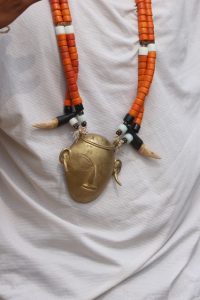
an amulet in the form of a head is a popular piece to wear, in the old days representing head hunting success

two more youngsters, also on the way to celebrations; Land of Angh refers to the Mon district, the homeland of the Konyaks in Nagaland
The reason to come all the way to Longwa is the Aolyang festival, a kind of new year celebration, the start of a new growing season, for the Konyak tribe. It is a six day festival and although Longwa is the tribal centre, already long before we reach Longwa we see the signs of the celebration. Mainly young people seem to be on their way, dressed up with sashes and necklaces; some are pretty drunk, or high, I don’t know. A group of them is almost rolling down the steep slopes of a local tea plantation, the first Naga tea we have seen so far.
Mon
In Mon, the regional capital – and not particularly attractive, from the looks of it -, we have to register with the local police. Copies of the passports, visa, and of our ILP, all written in another great big book of Santa Claus, together with the name of our guide. Nothing complex, and yet it takes almost half an hour. We finally depart, with the stern warning that we need to check out again, once we leave the area.
next: Longwa

